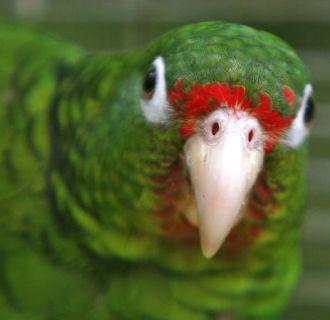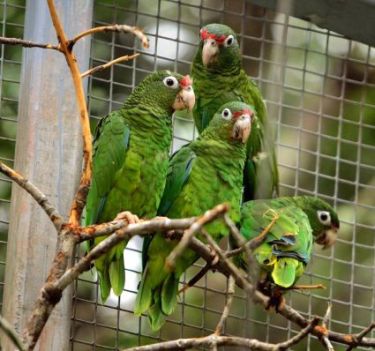 The Puerto Rican parrot, Amazona vittata, was once abundant in Puerto RicoFederal and local agencies are sticking solidly behind a program to boost the population of endangered Puerto Rican parrots.
The Puerto Rican parrot, Amazona vittata, was once abundant in Puerto RicoFederal and local agencies are sticking solidly behind a program to boost the population of endangered Puerto Rican parrots.
The Puerto Rican parrot, Amazona vittata, was once abundant in Puerto Rico, including the islands of Culebra, Vieques and Mona. This parrot is now one of the most endangered birds in the world and the last species of psittacine extant and native to the United States.
In pre-colonial times, there were an estimated 1 million of the birds spread across Puerto Rico. Intensive agriculture, particularly the massive clearing of forests for sugar cane, coffee and citrus, and a series of devastating hurricanes destroyed most of their prime habitat. By the late 1960s, they had disappeared from the entire island, except a few dozen in El Yunque, a mountainous tropical rain forest east of San Juan. In 1975, a census found just 13 birds left in the wild.
But a captive-breeding effort has been paying off.
During an interagency meeting this month, leaders from the Puerto Rico Department of Natural and Environmental Resources (DNER), the U.S. Forest Service (USFS), and the U.S. Fish and Wildlife Service (USFWS) reaffirmed their commitment to the Puerto Rican Parrot Recovery Program, and their relationship as collaborators, by renewing a memorandum of understanding (MoU).
The agreement commits the agencies to complete major milestone targets as described in the Puerto Rican Parrot Recovery Plan. The MoU also describes the values and principles underpinning the collaboration. To facilitate mutual understanding and agreements, the MoU also includes a commitment from leaders at the executive level to meet every year and formally lays out a blueprint for the existing collaborative framework between managers and operational teams in all three agencies.
Under this agreement among the agencies, significant successes have been achieved, paving the way towards the recovery of the species.
The captive population occurs in two aviaries in eastern and west central Puerto Rico. During the 2012 breeding season that ended last week, both aviaries produced 71 chicks. The overall number of captive and wild birds is estimated to be close to 400 of which 58 to 80 are in the wild.
The consistent, periodic release of birds into the wild, while maintaining a captive flock for reproduction and saving some of the young for a third population has been a tremendous achievement. In January 2012, ten parrots were released into the Rio Abajo State Forest (Arecibo and Utuado) and seven into El Yunque National Forest (Río Grande). Later this year, two new breeding pairs will be reintroduced to El Yunque National Forest.
 The consistent, periodic release of birds into the wild, while maintaining a captive flock for reproduction and saving some of the young for a third population has been a tremendous achievement.Since 2009, the team has saved some parrots to be released eventually at a third location in the island of Puerto Rico. At the present time, the agencies are in the planning stages for the development of a third population in the wild. Although a final location has not been decided, the preferred alternative continues to be the Maricao State Forest.The agencies are working with private landowners and other conservation partners in Yauco, Maricao and other areas, evaluating habitat conditions while promoting reforestation and other habitat restoration practices to promote forested habitat for wildlife, including the Puerto Rican parrot.
The consistent, periodic release of birds into the wild, while maintaining a captive flock for reproduction and saving some of the young for a third population has been a tremendous achievement.Since 2009, the team has saved some parrots to be released eventually at a third location in the island of Puerto Rico. At the present time, the agencies are in the planning stages for the development of a third population in the wild. Although a final location has not been decided, the preferred alternative continues to be the Maricao State Forest.The agencies are working with private landowners and other conservation partners in Yauco, Maricao and other areas, evaluating habitat conditions while promoting reforestation and other habitat restoration practices to promote forested habitat for wildlife, including the Puerto Rican parrot.
The interagency team is also gathering support from private organizations, NGO’s and college groups interested in implementing different aspects of the Puerto Rican Parrot Recovery Plan.
Under the previous MoU, great strides were made. The Iguaca Aviary was built, and both the Iguaca and the José L Vivaldi Aviary were fully equipped with state of the art technology that facilitated the highest production of parrots in the project’s history. Also, a second wild population was established in Puerto Rico, which has achieved 10 active nests since the first reintroduction of parrots in the Rio Abajo Forest in 2006.
The integration of the staff from all three agencies into a single working unit has been integral to attaining these goals. Also, having a single veterinarian attending at both aviaries, Dr. Antonio Rivera, has allowed access to consistent and equal care for all parrots regardless of location.
In moving forward with common long-term goals, the renewal of the MoU is expected to continue to build on past achievements by promoting the exchange of information among cooperators, minimizing duplication of conservation efforts and continue providing the resources, both human and financial, to support the continued implementation of Puerto Rican parrot recovery.